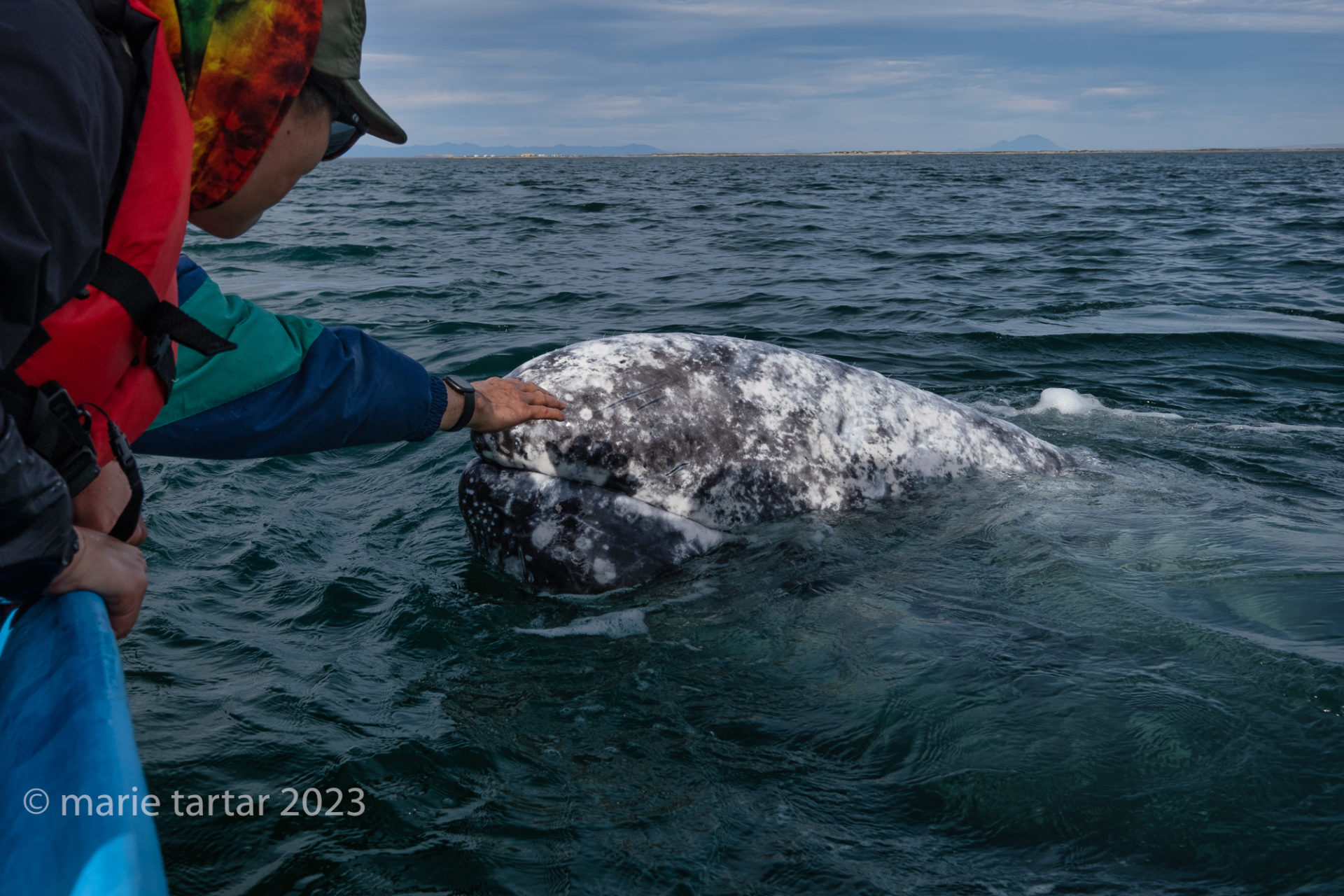
Finally! I have wanted to visit the gray whale nurseries of Baja Mexico for literally decades, ever since the 1990s, when we moved to San Diego, where whales blows can be seen offshore in the winter months as they make their annual migration south along the California coast to their winter watering holes on Mexico’s Pacific coast. This trip had been on my bucket list since well before that term came into play. Over the years, I looked into a variety of options, many incorporating long drives back and forth from San Diego or traversing Baja, which sounded too time-consuming. Other years, the January-March window quickly filled with other enticing options.
We had only ever seen one gray whale at close range, despite hours underwater off California’s coast (it is possible but extremely rare for a diver to see a gray whale underwater). That gray whale was J-J, a calf rescued in dire condition in January 1997 and raised at Sea World for 14 months before being released into the wild in March 1998. J-J was semi-comatose, dehydrated and alone, found rolling in the surf on a Los Angeles beach. At the time, a gray whale had never been successfully kept in captivity. Sea World in San Diego was the only facility with the resources to attempt caring for a gray whale. She was rehydrated with tons of fluid and electrolytes, restoring her ability to swim. Sea World staff had to concoct a food mixture resembling pancake batter (powdered milk, water, ground up fish, vitamins and nutrients) to substitute for a mother’s milk. J-J began gaining weight and growing, at a rate of 50 pounds/day. She graduated to being feed solid food by hand, 55 buckets of sardines and herrings/day, to feeding on her right side on food placed on the bottom of her tank, similar to how gray whales feed in the wild. J-J’s story captivated the public’s imagination, including us. While J-J was a San Diego resident, we made a rare visit to Sea World specifically to see her.
What attracts the gray whales to the lagoons along Baja’s Pacific coast? Warm shallow waters provide a relatively sheltered environment in which pregnant females can give birth and nurse their calves, who need 1-2 months to grow and gain enough blubber before heading north on the 5000 mile migration to summer feeding grounds as far north as the Arctic. Other gray whales mate in the area.
In the waning months of 2022, I had whales on the brain, thanks in part to my obsession with TV’s Extraordinary Attorney Woo, a charming Korean show about an autistic lawyer obsessed with whales, which she sees everywhere, in the clouds, floating past the subway on the way to work, even at inopportune moments interacting with her stunned colleagues.
In the fall of 2022, after a blitz of make-up trips postponed by the pandemic, we decided to try renting out our red rock getaway in Sedona. All of that travel meant we had a 6 month stretch between stays. Arriving in August, we found a roof leak and one of the HVAC units had failed. We concluded the house might do better with more continuous occupation. Our neighborhood only permits monthly rentals and we weren’t interested in shorter term rentals, à la AirBnb. After considerable prep work, cleaning out closets and drawers, we signed on with Vacasa and our listing went live.
To our surprise, in short order, we had first one, and quickly thereafter, another month booked. A couple of month-long bookings for the following spring quickly appeared on the calendar. That answered the initial question, would the house rent on a monthly basis? Even more surprising, the renter for December suddenly extended their month-long stay by another month…and then added on several more weeks, right up until our planned return for the annual Sedona International Film Festival at the end of February.
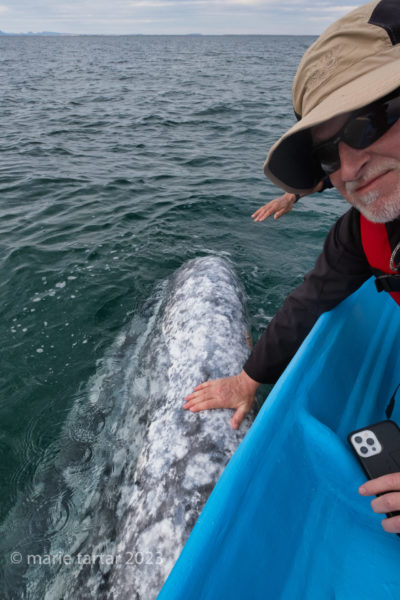
Steve required a little (gentle) arm-twisting but seemed to enjoy stroking the “chubby rubber” of our favorite San Ignacio gray whale, Sand Dollar.
All of which is a long-winded way of saying we couldn’t go to our Sedona house for our week off in January. I found a 5 day trip on Baja Expeditions website and engaged in some gentle (persuasive) arm-twisting of Steve to go along with my alternate plan. He had proposed a return to Death Valley, as winter is its best season. We had a full 10 days off, so there was time enough to do both, marital compromise at its finest. Greg coming along was apropos, as we all have a long history with Baja Expeditions. It was in Baja on their dive boat, the Don Jose, that we first met 30 years ago. Our friendship was cemented 6 months later, when we found ourselves together again (randomly) on yet another dive boat, the Wave Dancer in Belize. I took that as a sign from the universe that we were destined to be friends and we’ve been traveling together ever since: Papua New Guinea, Solomon Islands, Iceland, Chile, Norway, Cuba, Indonesia, Antarctica and more.
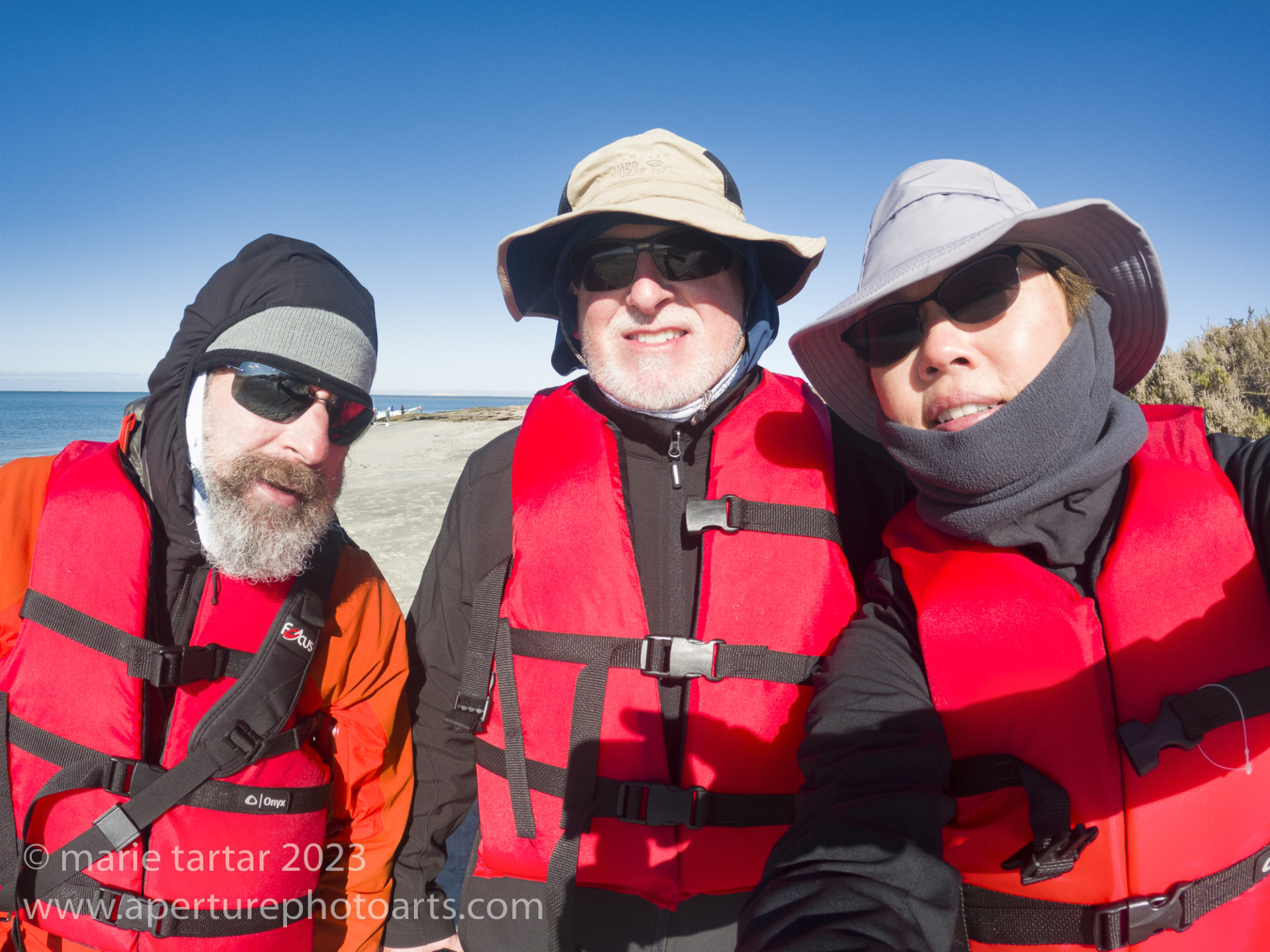
Tres amigos go whale watching or what the well-dressed whale watchers in Baja’s San Ignacio Lagoon are wearing this season: lots! Lots of layers and lots of sun protection. It was surprisingly chilly at camp and on the water. I usually had on 4 upper layers, plus the mandatory life preserver and 2 layer pants.
This glamping adventure had us flying down to Los Cabos, with a whale watching excursion the same afternoon to entertain us, before flying early the next morning to San Ignacio Lagoon, nearly halfway back up the Baja peninsula. The small Cessna and its 25 pound weight limit per person presented the greatest challenge of this trip: packing, naming deciding what gear to bring and what couldn’t make the trip. The weight limit also scared us into going a little too light on clothing, leaving behind some layers we could have used.
Thursday, January 26, 2023
Alaska’s daily non-stop to Los Cabos leaves at 7 am, which means a dark o’clock departure for the airport, at an hour I was unwilling to take a chance on there being a nearby roving Uber driver. The Howard express is always on time and at 5 am, we were on our way. This being only a 2 hour flight, none of us had sprung for first class tickets, but happily, all 3 of us received notice of free upgrades the day before, which always makes any trip just that much nicer.
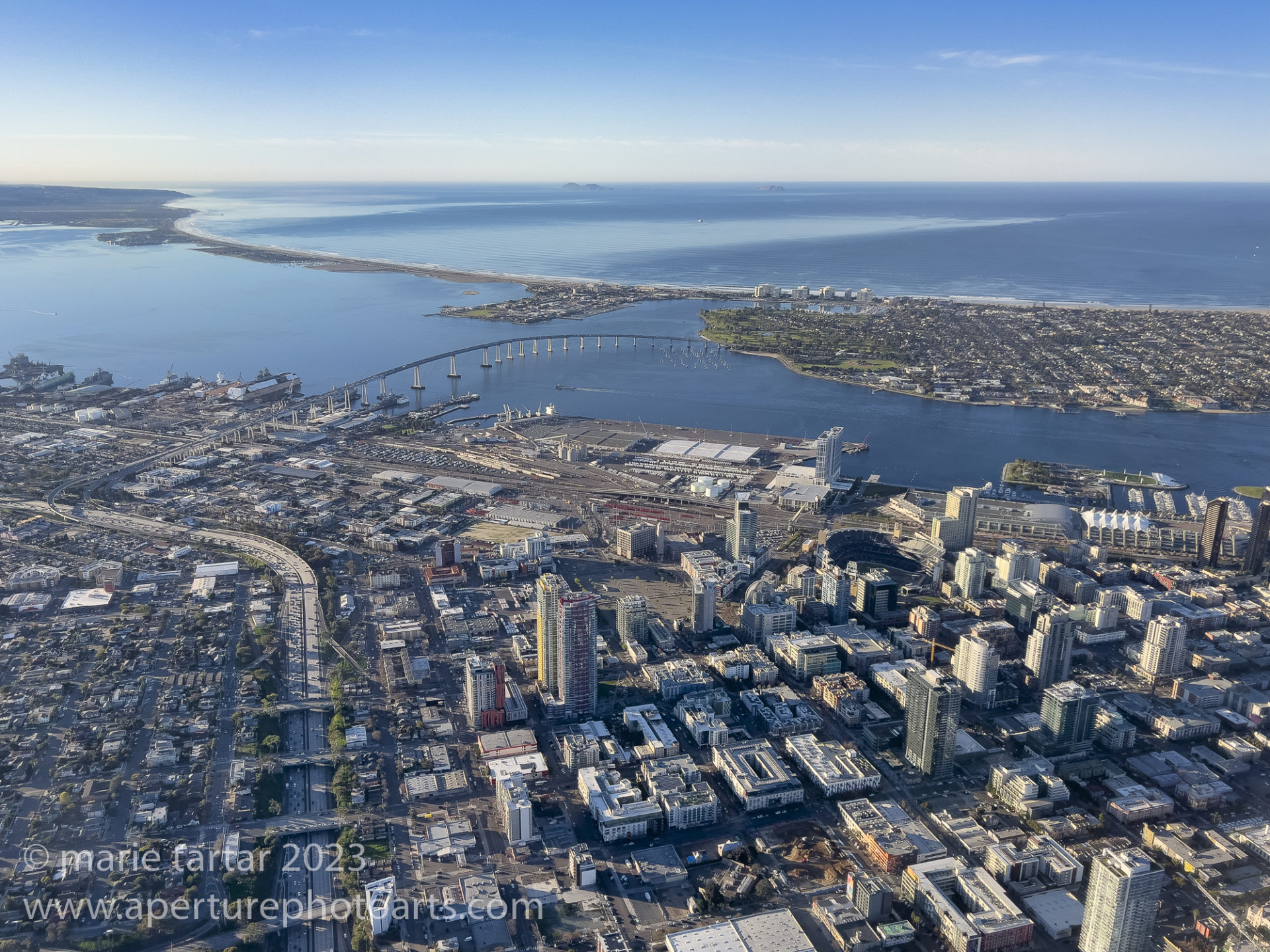
One advantage of an early departure: nice light. San Diego was looking especially lovely this morning. Beyond the Coronado bridge and the Silver Strand, the Coronados Islands in Mexican waters can be seen.
We didn’t make it into San Jose del Cabo in time for the Backscatter morning photo seminar, but our late morning arrival did leave just enough time to check in at the office and grab a quick lunch (scallop tacos for me) down the street from SeeCreatures at an open air restaurant (Claro Fish Jr.) before hustling back for the 1 pm pick-up for the run to the marina and the whale-watching outing. Deep water upwellings off the seamounts of nearby Gordo Banks attract marine life.
Although gray whales (Eschrichtius robustus) were the focus of this trip, this afternoon was devoted to humpback whales, always a delight to see. Even better is swimming with them, which we’ve enjoyed before in the Dominican Republic and French Polynesia.
Steve, Greg and I ended up in a panga of our own, with the rest of the party on a larger boat. All eyes were trained on the water, looking for blows. We didn’t have long to wait.

Whale watching near San Jose del Cabo, Baja, Mexico: Good view of the hump for which humpback whales are named. The other explanation I’ve read is the hump refers to the rounded appearance of a humpback’s back just before a whale dives.

Just what every whale watcher hopes for: repetitive breaching by a humpback whale-breathtaking! Near San Jose del Cabo, Baja, Mexico.

Humpback whale breach, near San Jose del Cabo, Baja, Mexico: It isn’t really known why whales hurl their mighty bulk out of the water, sometimes repeatedly. I like the theory that it is for the sheer joy of it.
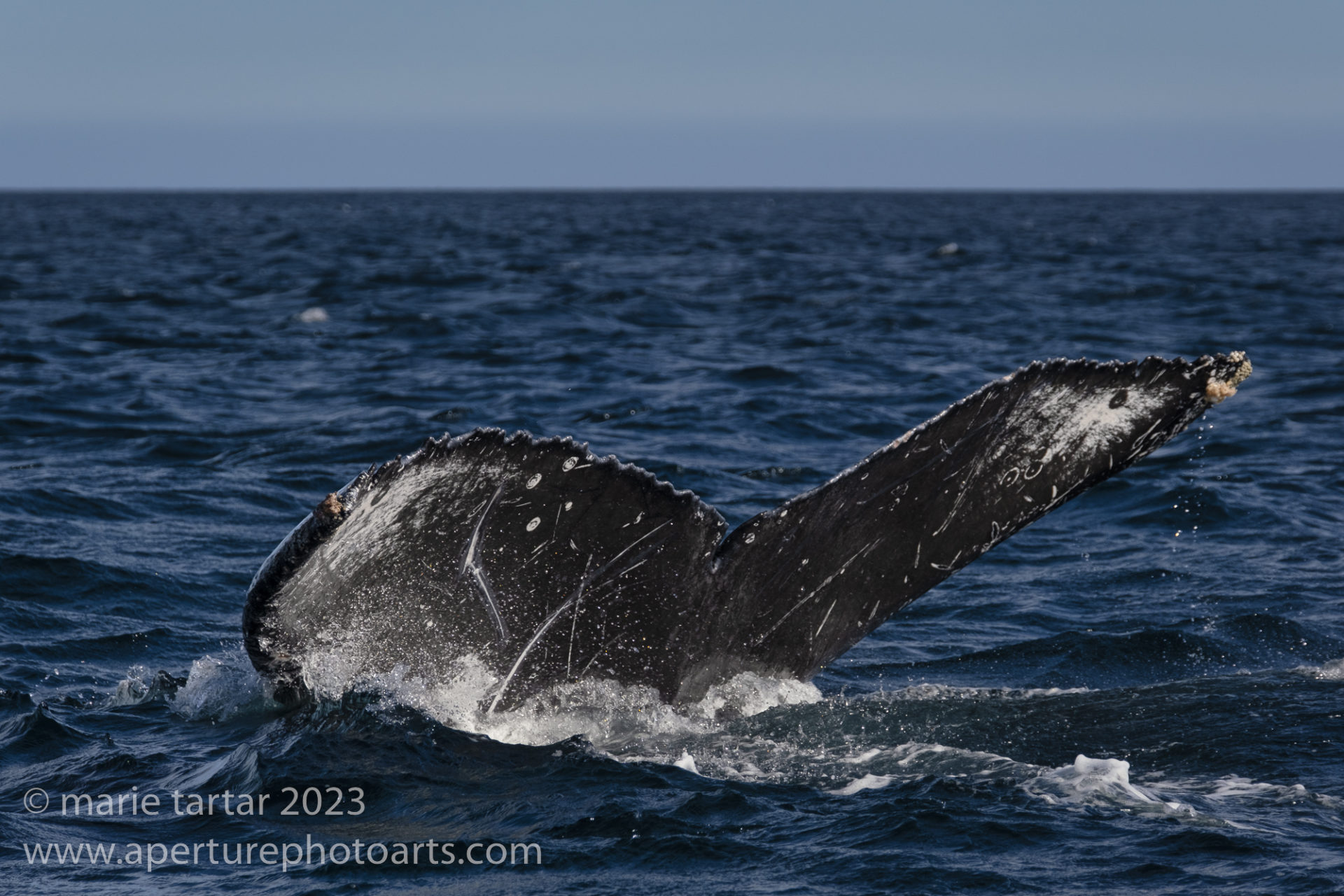
Fluking is nice too! Humpback whales can be identified by the unique markings on their tails. Near San Jose del Cabo, Baja, Mexico.
Back at El Encanto, the boutique hotel in the Arts District we stayed in before our October Baja dive trip, the neighborhood was heating up for the weekly evening art walk. We retreated in favor of a quiet evening over a good meal at the farm to table restaurant Los Tamarindos, which we enjoyed on our prior stay. In October, we were there after heavy rains washed out the most direct road to the restaurant. This time, our Uber driver took us on that road, which was dirt covered with thick sand, until he stopped where we could see the twinkling lights of the restaurant down a sandy stretch. He held up his phone with Google translate saying: “I’m afraid my car will get stuck.”
It was worth the trudge down the sandy track for the meal of coconut milk ceviche, grilled prawns with chimichurri sauce, beet and arugula salad and (for me) roasted cauliflower.
Friday, January 27, 2023
It was another up in the dark morning for us. We wheeled our luggage to the end of the cobblestone street and waited for the bus scooping up the guests from various hotels to come by for us at 6:40 am.
The almost 2 hour charter flight on a small Cessna was scenically spectacular, over the granitic Sierra de la Laguna mountains. Despite being to Baja many times, visually, flying low altitude vs. commercial, was incomparable!
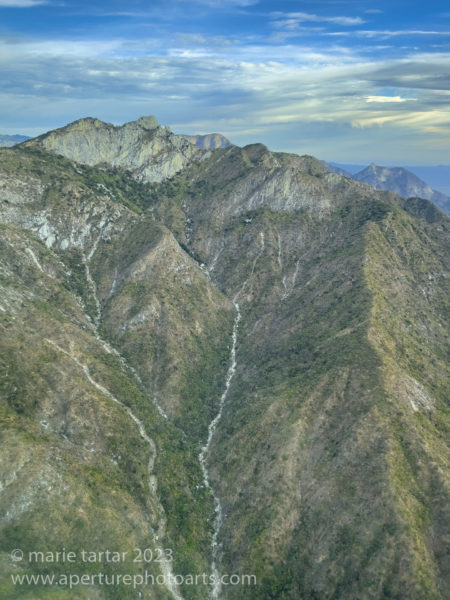
Magma lifted up sediment which cooled into granite to form the Sierra de la Laguna in southern Baja, Mexico, roughly 100 million years ago.
After a smooth touchdown on the compacted dirt landing strip on the south side of the lagoon, we were outfitted with white rubber boots (ugly, but mostly effective), but not the promised jackets (I think something was lost in translation: the literature says “windbreakers” are provided, the website says “jackets”; when I asked, the response was that “life jackets” were provided; a rather important difference). Steve and I ended up buying Baja Expeditions logo windbreakers since we both were freezing (yes, even Steve “The Furnace” Eilenberg, was cold). We had to wade a bit to reach the beach where our camp on the north side of the lagoon awaited-for some of us, that meant cold water coming over the top of the boots and wet feet. Once we were reunited with our luggage, that was easily remedied with fresh socks.
After a light sandwich lunch, we were sorted into groups for our first on-the-water excursion, with Ranulfo Mayoral as our guide and Juan as panga driver. Ranulfo has a VERY long history as a whale watching guide in the lagoon (40+ years), as his father Pachico was the first to have friendly interactions with gray whales, in 1972. 1972 was an important year for whale related events. San Ignacio Lagoon was designated by the Mexican government as a “Reserve and Refuge Area for Migratory Birds and Wildlife”. The United Nations voted for a resolution calling for the end of worldwide whaling and the U.S. Congress passed the Marine Mammal Protection Act, followed up in 1973 with the Endangered Species Act, which included the gray whale.
Steve and I were paired with a very fun and congenial group, including another doctor couple from San Diego, Kathie and Young, and friends from the D.C. area (Aimee and Amber). All were enthusiastic and exuberant whale watchers, Aimee positively bubbling over with baby talk and whale attraction wiles.

We had the best panga group at San Ignacio Lagoon, in Baja, MX. From front to back: Aimee, Amber, Kathie and Young, Steve, guide Pato (duck in Spanish)/aka Esteban and driver Juan.
Greg was paired with a nice family from Monterrey, Mexico (Regina and father and engineering college student son Abel and Abel) and Garid, an amiable dive instructor from Hawaii.
Amber didn’t come out for our first outing. Happily, a friendly, splotchy adult gray whale did-twice! We recognized her by a large, distinctive white patch on her right shoulder, a characteristic for which Aimee instantly dubbed her Sand Dollar. You can vicariously experience a close gray whale encounter here.

Even better when a huge snout (rostrum) appears next to the boat! Sand Dollar! Our favorite gray whale in San Ignacio Lagoon, Baja, Mexico.
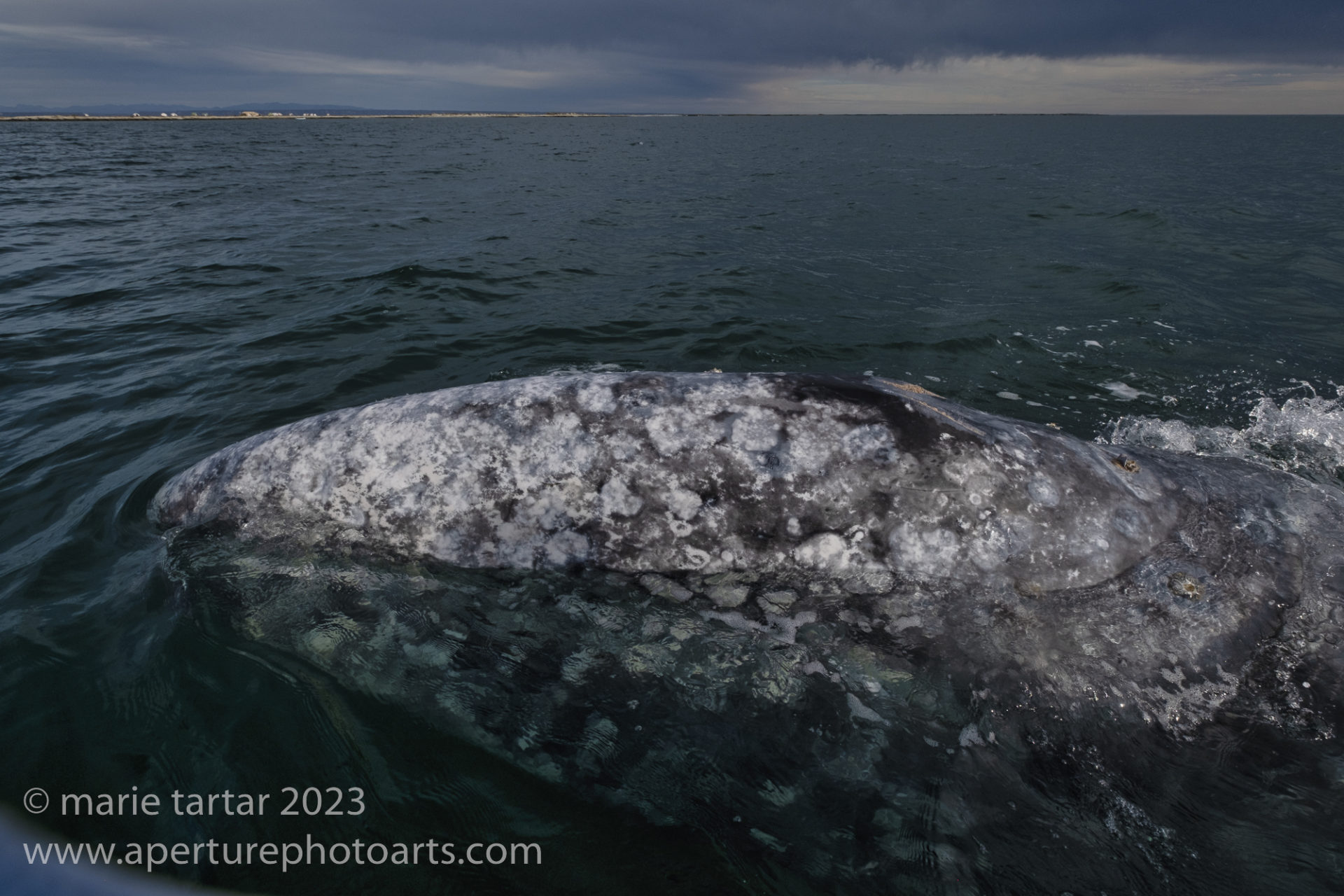
A speckled submarine sized Sand Dollar alongside our panga prompted cries of “You’re so pretty!” from Aimee.
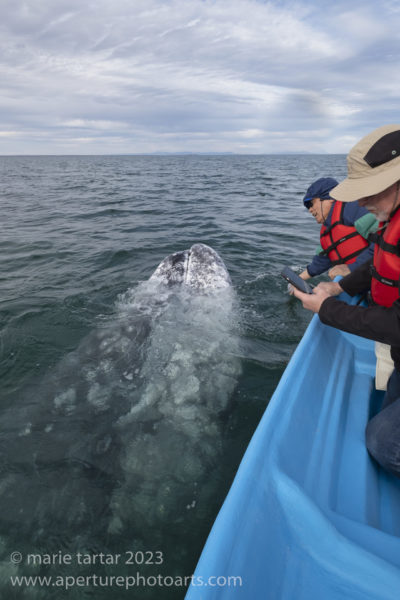
Yes, San Ignacio’s gray whales are at least as big as our 27 foot pangas. Sand Dollar scraped up against our boat several times without perturbing it. They are certainly capable of overturning a boat if threatened. It’s hard to believe but gray whales were among the most feared by whalers, called “devil-fish”. Whaling in Mexican lagoons on the Pacific coast severely threatened the existence of gray whales, down to an estimated 250 animals in the 1930s (from 20,000 in pre-whaling times). Gray whale numbers are believed to have nearly recovered to pre-whaling day numbers since protections were enacted, enough that they were removed from the endangered species list in 1994.
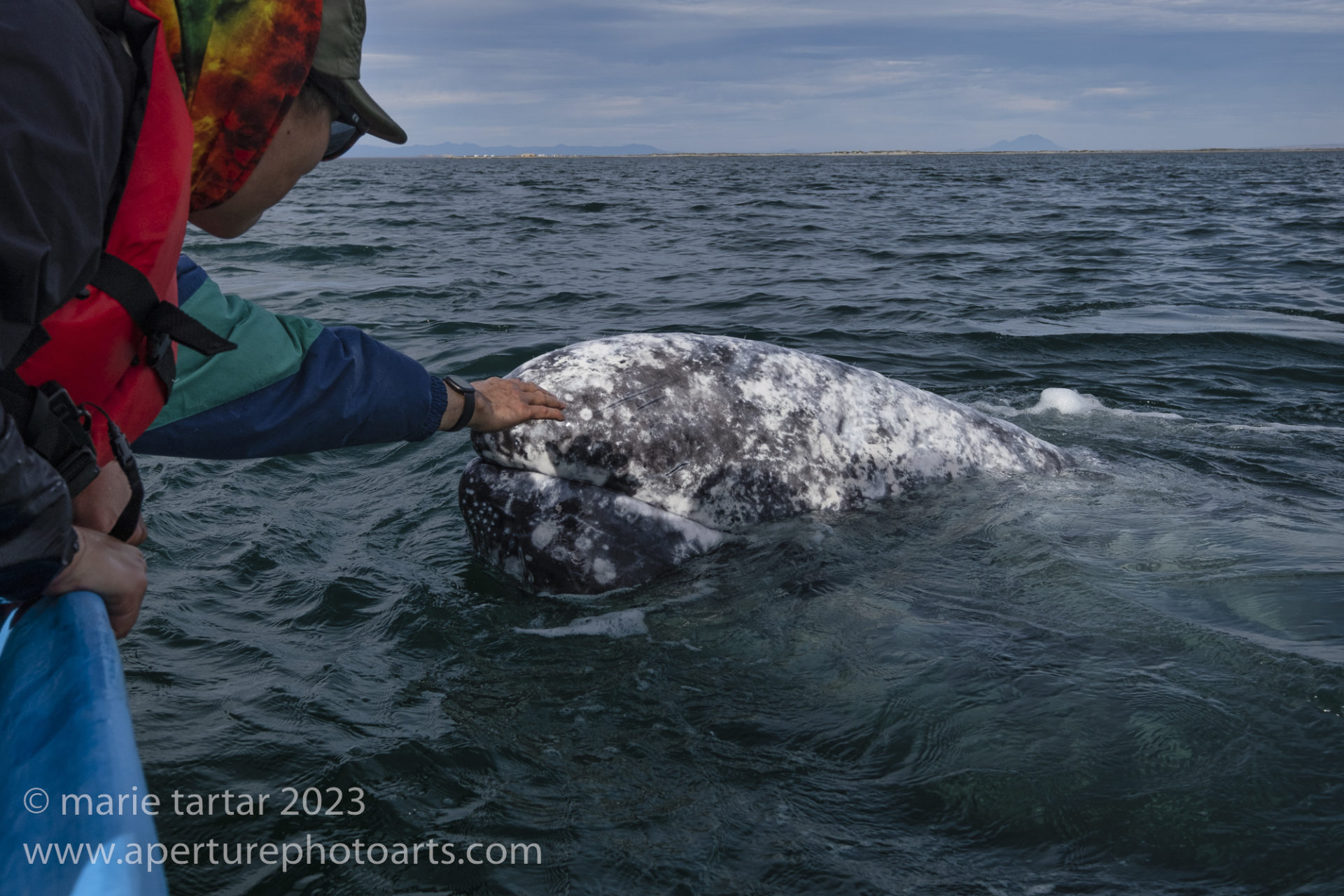
Young leverages his height advantage in stroking Sand Dollar while Aimee sweet talks her into coming closer (San Ignacio Lagoon, Baja, Mexico).
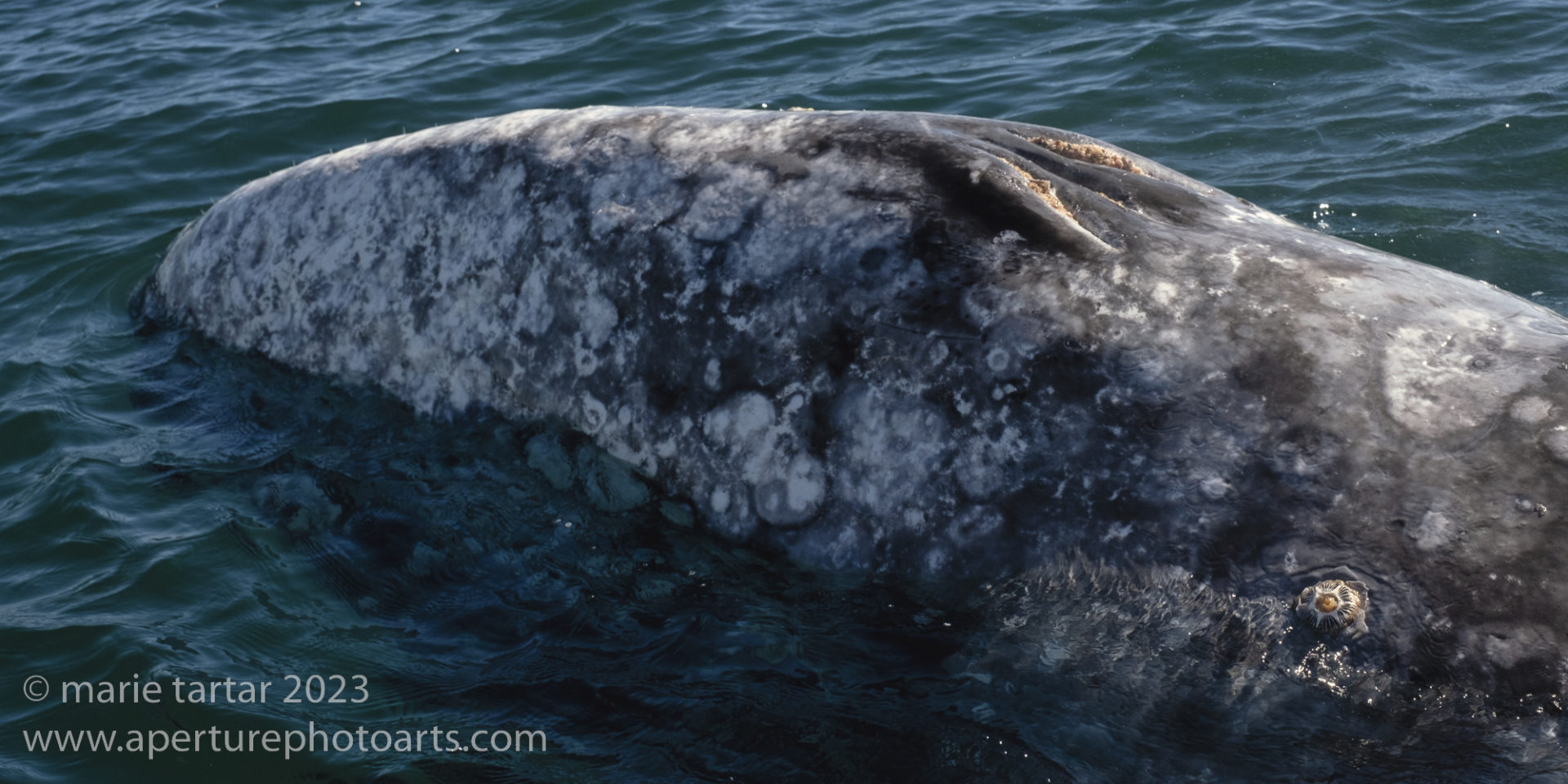
Close view of a gray whale’s blowhole, a no-touch area for us (San Ignacio Lagoon, Baja, Mexico). All baleen whales have a double blowhole, like this.
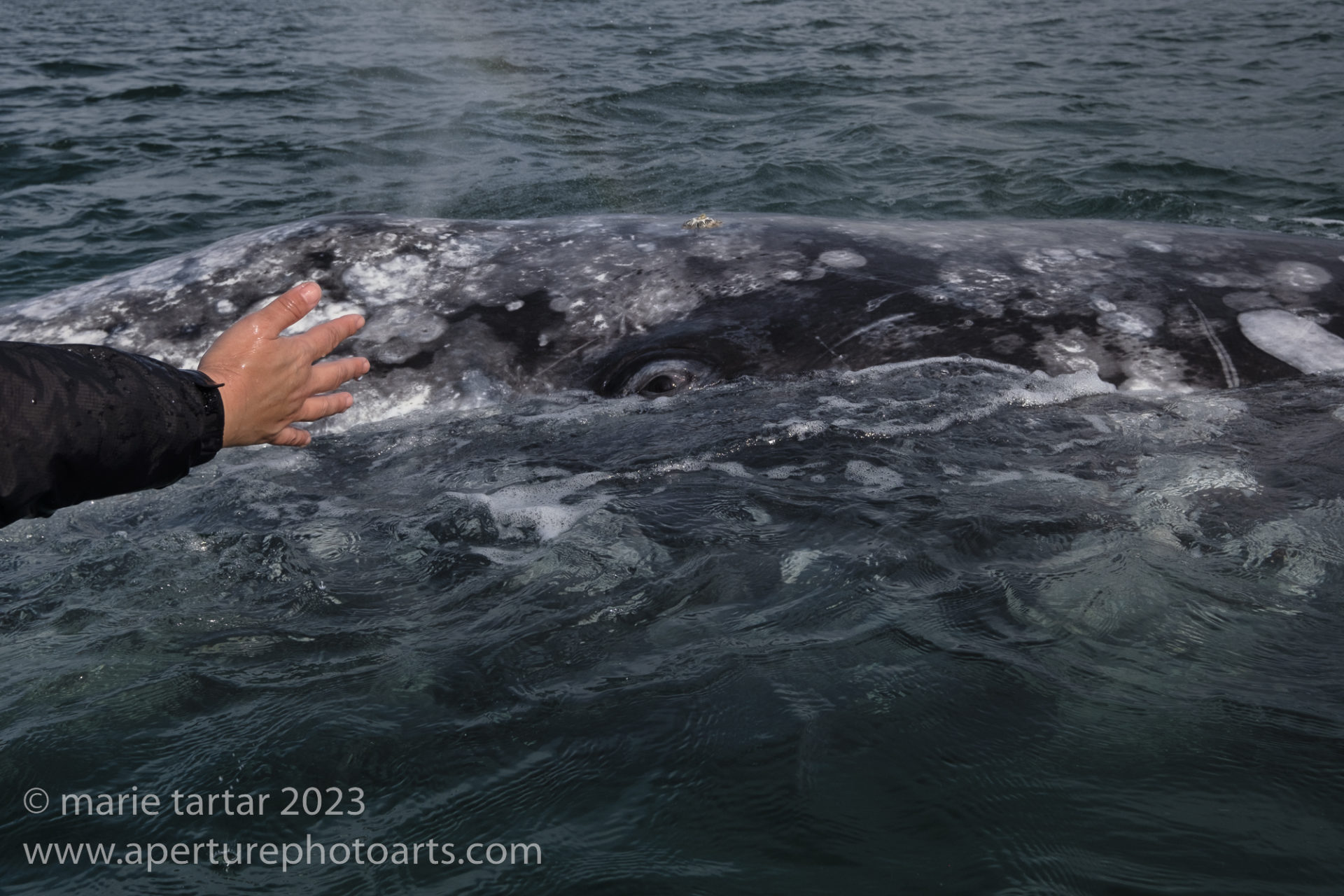
Connection and communication, wo(man) to whale. With a blow still in the air, Sand Dollar the gray whale’s giant eye assesses the proffered urgent hand of Aimee that says “Come closer!” Every time I see this image, I find myself thinking of the ceiling of Michelangelo’s Sistine Chapel, with man reaching out for the hand of God-is that hubris?
Saturday, January 28, 2023
On our first full day, we settled into our new routine: breakfast at 7 am, shoving off in the pangas at 7:45 am (beating the other outfitters out), checking in with the sanctuary “sheriff”, who marks the line dividing the reserve into no-go and ok-to-go areas. We could spend 90 minutes on the water, then would have a beach and bathroom (green latrine) break before another 90 minute session, after which we’d head back to camp for lunch.
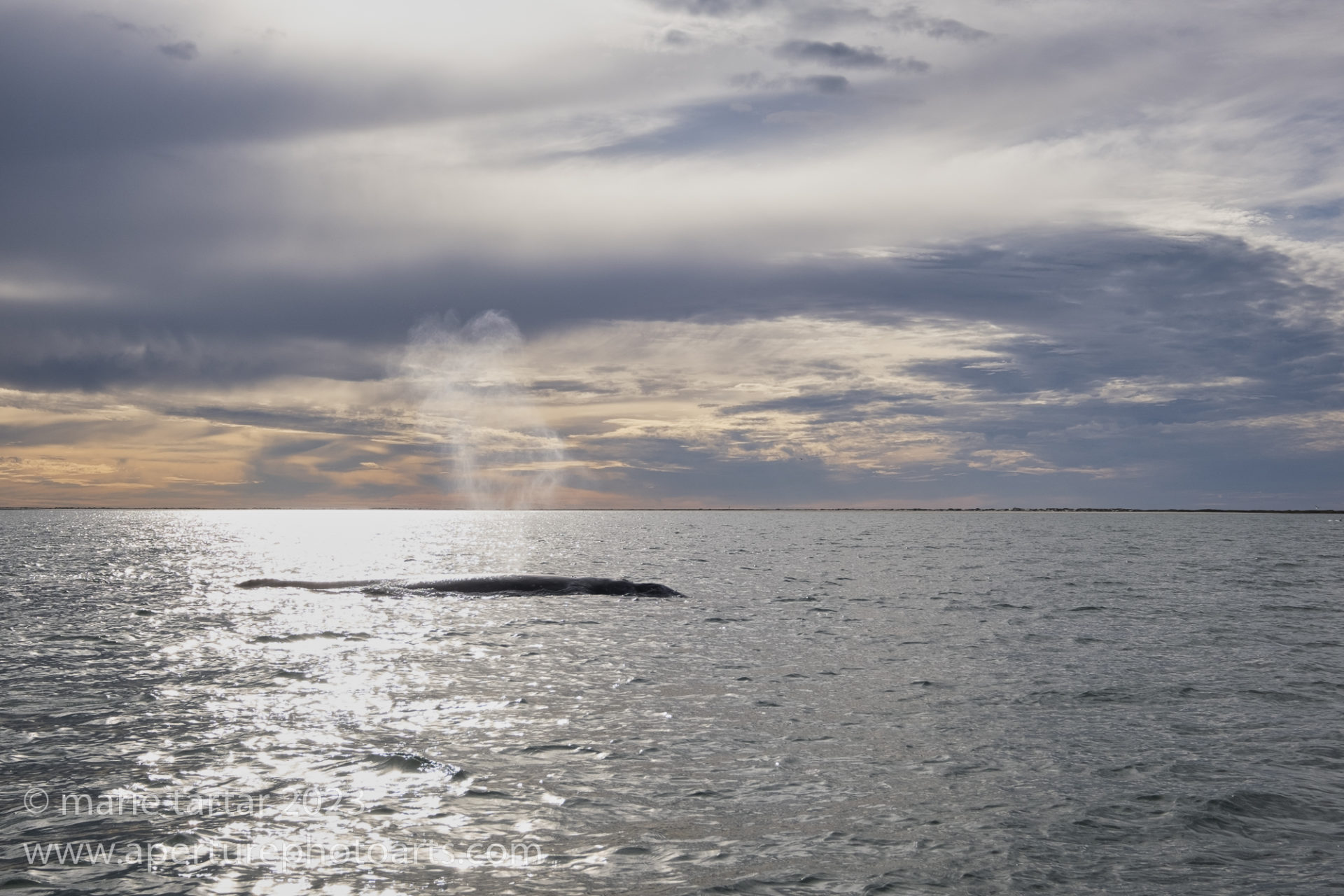
Lots of blows and whale sightings on our first full day on the waters of San Ignacio Lagoon, but none of the Sand Dollar loving we’d come to crave after our first afternoon. Exhaled whale breath is air, powerful enough to form mist from the water surrounding the blowhole.
The afternoon session began at 2:30 pm and we had to be off the water by 5 pm. This left time for showers, happy hour and dinner. Since this was a rather quiet day, with many sightings but no close approaches or petting, I’ll mention the food on this trip was delicious! Breakfast today included choices of eggs to order, eggs Benedict, carrot bread, hash browns and fruit. Dinner included a dynamite raw beet salad, very succulent and tender beef and mashed potatoes. We were again out with Ranulfo and Amber joined us for her first outing on the water.
Despite our best efforts with sweet talk, splashing water, positive thinking, you name it, we had to be content with our memories of the prior day’s interactions and put our hope in our remaining full day.
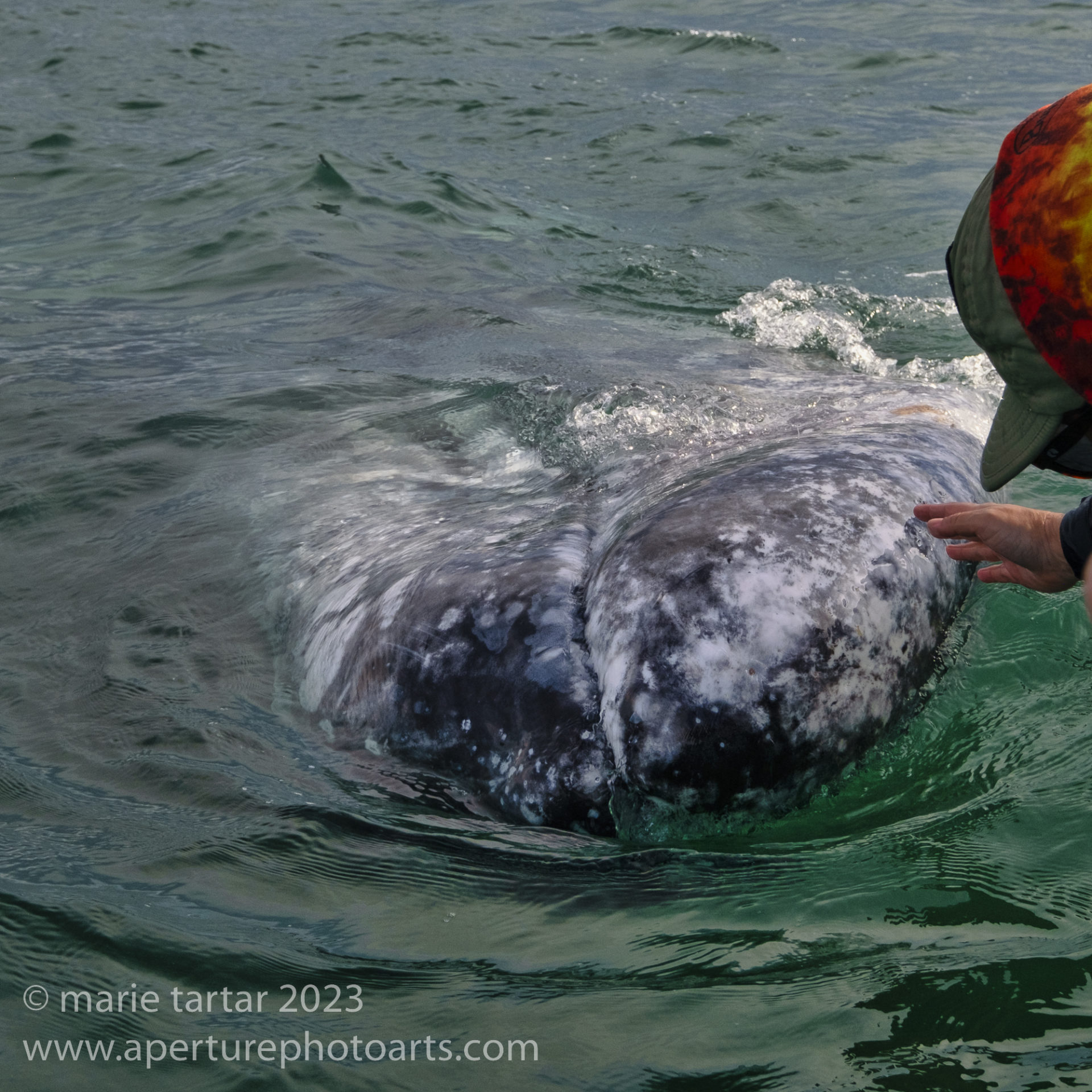
What we wanted on our first full day on the water in San Ignacio Lagoon: more of Sand Dollar’s attention, like the prior afternoon.

Whale watching in San Ignacio means lots of waiting and a need for patience and perseverance: It isn’t always exciting. Steve was smart and brought his Air Pods and listened to books during the lulls.
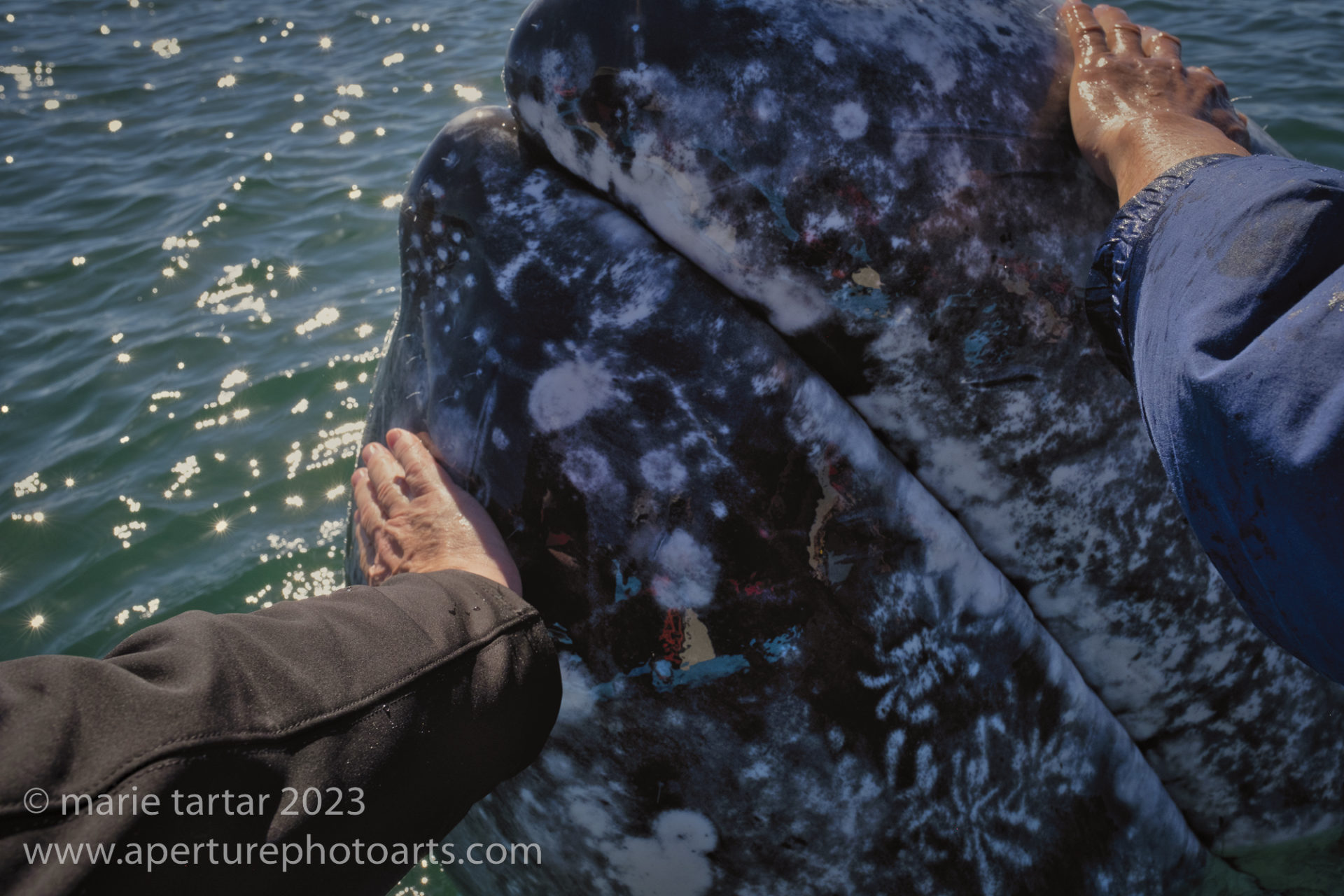
Steve and Young, petting Sand Dollar in tandem, trying to keep her at our boat’s side. I suspect those colorful splotches are paint from bumping up against boats. The white splotches are reminders of previously attached barnacles.

Another group in the Gray Expectations boat tries to coax Sand Dollar closer in San Ignacio Lagoon, Baja, Mexico.

Small boat with eager passengers, big gray whale, in San Ignacio Lagoon, Baja, Mexico. The lagoon is a misnomer-it is a large bay with sheltered calm areas in which gray whales give birth and nurse their calves to a size capable of northern migration to Alaskan feeding grounds.
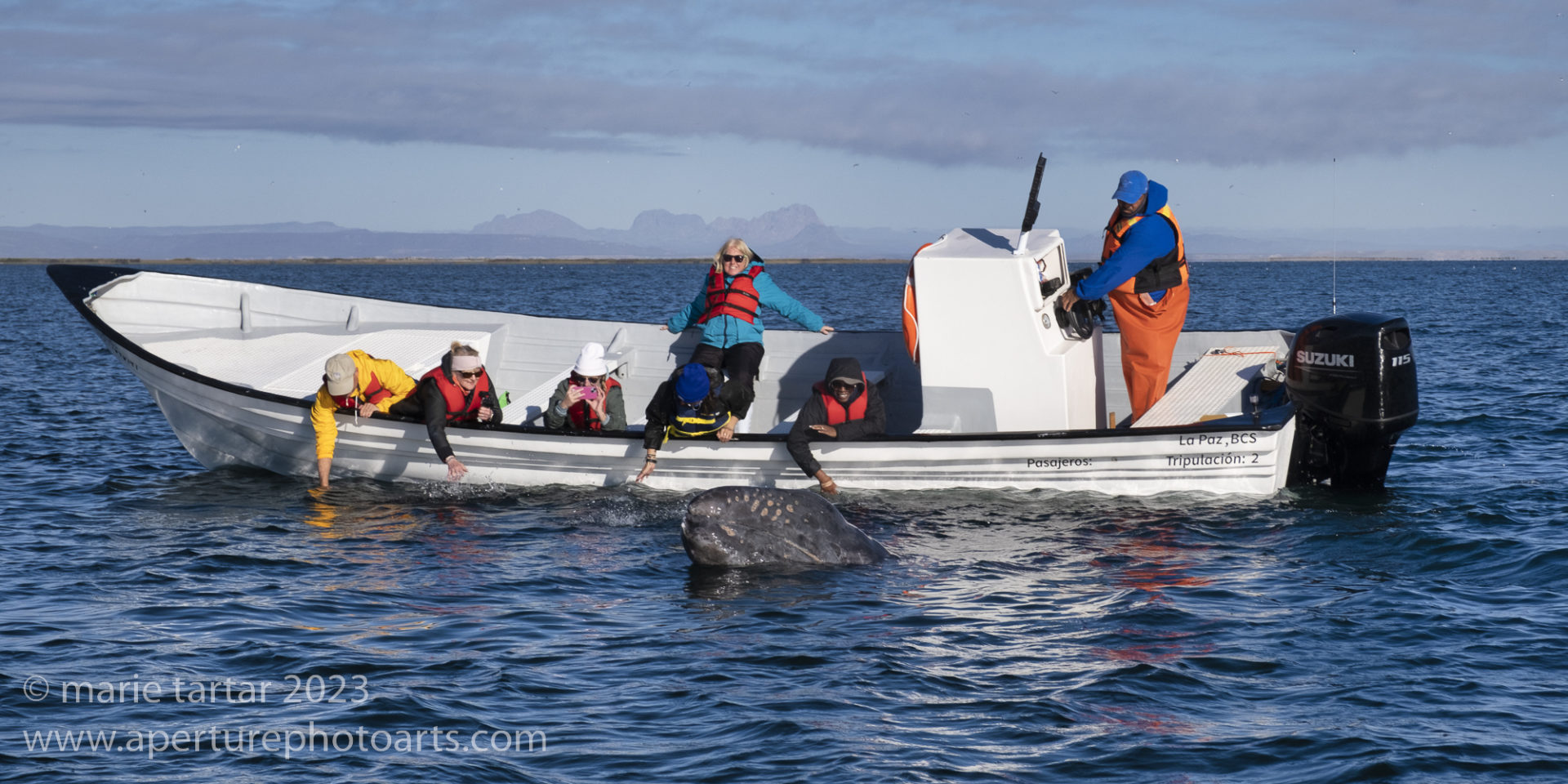
We had to be content on day 2 in San Ignacio Lagoon with seeing one of the other boats have a close pass with a baby gray whale.
Greg succeeded, with the aid of the Star walking app on his phone, in locating the green comet. Visually, it was a smudge.
Sunday, January 29, 2023
Our Mexican breakfast was a warming one, chiliquiles and machaca, two of my favorites. Thankfully, today was not the sleepy quest of the prior day. We set out with Pato and Juan and after crossing over the sheriff’s line (dividing the off limits whale sanctuary from the accessible lagoon), we were thrilled by a return visit from Sand Dollar. Squeals of delight greeted her return.
Aimee: “I’ve been looking for you since yesterday! My lovey!!!”
This was Amber’s first chance to touch her, which she accurately characterized as “chubby rubber”.
Back at camp for lunchtime, Steve and I had just enough Internet to watch our Bring a Trailer auction of my 6-speed manual 2000 Audi S4 come to a satisfying conclusion. We also learned, sadly, of the unexpected death of our New York neighbor and friend, Marilyn. We had texted back and forth on Christmas day and I had been thinking about her while watching my most recent TV fixation, Only Murders in the Building, a comedy drama about 3 strangers living in a New York apartment building who become friends as they band together to solve a murder in their building.
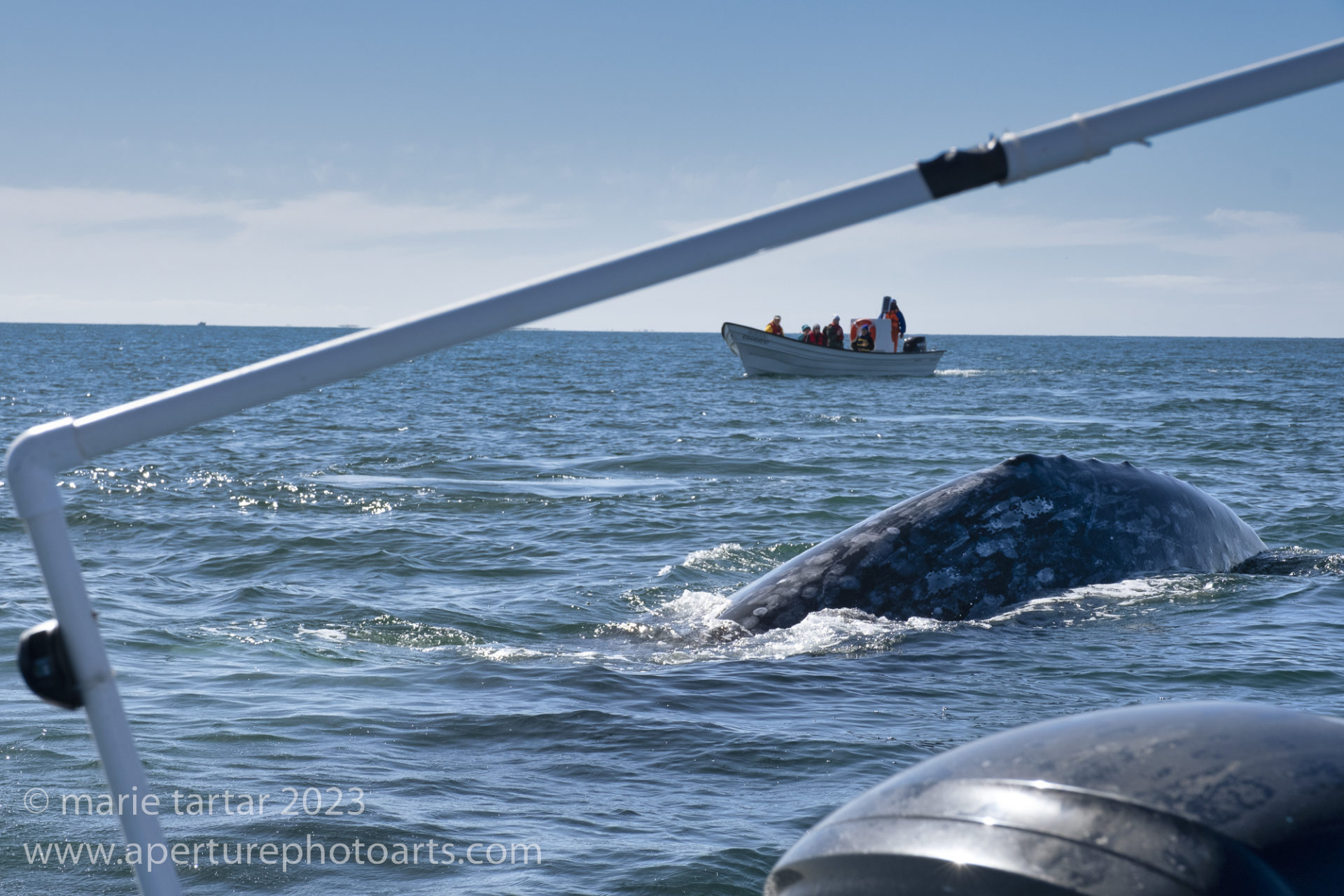
Now it’s the other boat’s turn to eye us with envy, as a gray whale approaches the back of our panga in San Ignacio Lagoon.
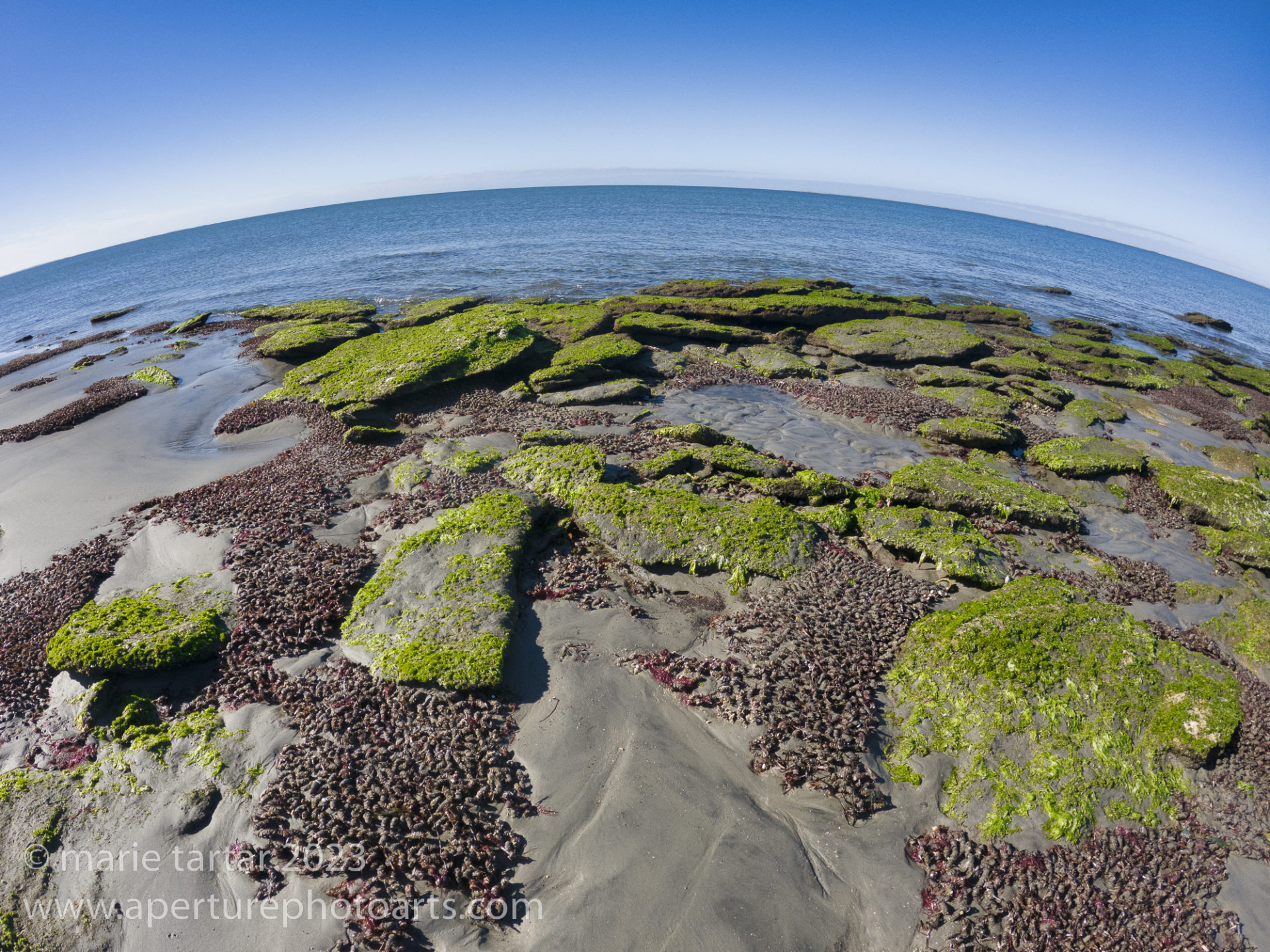
Our morning gray whale watching excursions in San Ignacio were broken up into two 90 minute sessions, with a beach break between.
Our boat’s success in attracting Sand Dollar’s repeated attentions did not go unnoticed, leading to one of the other groups insisting on commandeering our boat and driver for our final afternoon out, claiming that the whales must like the purr of that particular outboard motor over the others. We preferred to think it was our positive energy that Sand Dollar sensed in favoring us with her affection. Pato, who also functioned as a bartender, treated our panga group to a bottle of wine that night as a consolation prize.
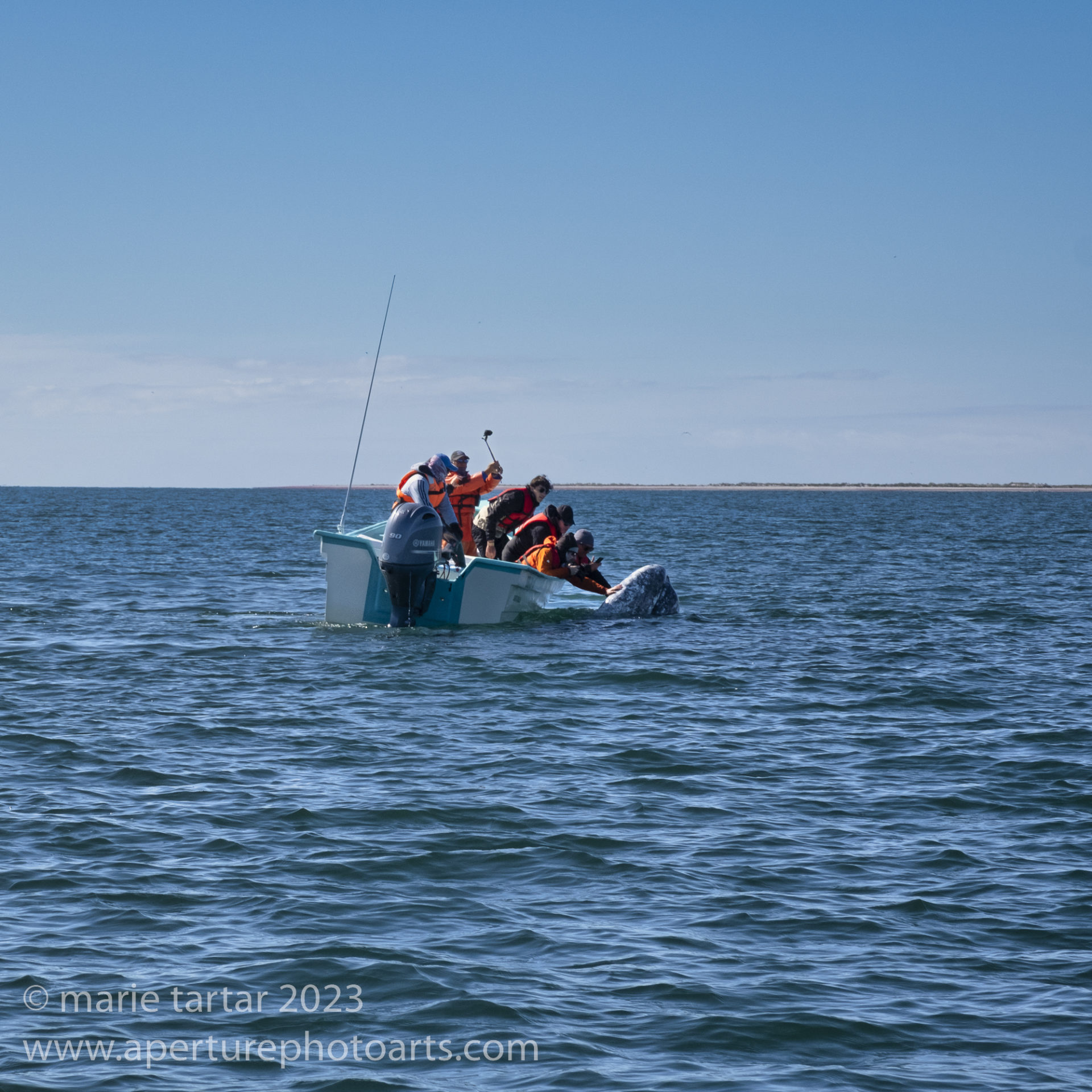
Greg’s group gets some face time with a gray whale in San Ignacio Lagoon. Abel Jr later hugged and kissed a whale.
Happy hour had an additional dimension that night: Just outside the bar, Pato manned a grill over which huge succulent local oysters were steamed open. Regina, Abel, Abel, Greg and I went crazy scarfing them down.

At our final “taco night” dinner, Abel Sr. pointed out the economic significance to Mexico of the gray whale sanctuary, with our San Ignacio Lagoon setting and its mountainous backdrop being featured on the most commonly used bank note in circulation, the 500 peso bill (functioning like a $20 US bill).
Monday, January 30, 2023
We had one last chance to commune with the gray whales on our departure, heading back via panga to the landing strip, where our Cessna awaited. Alas, it was a quiet morning.
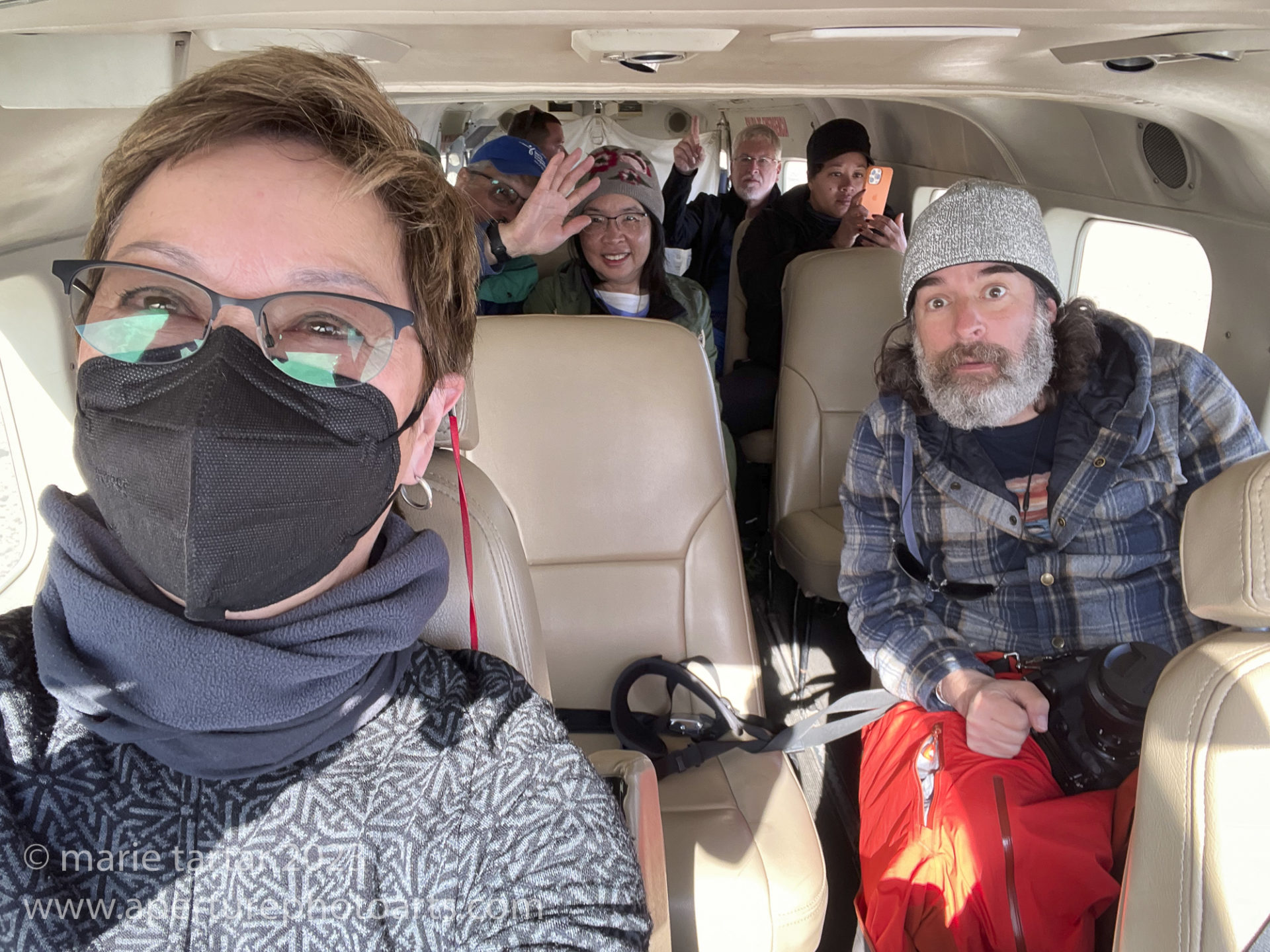
A motley crew of happy gray whale watchers in our small Cessna, heading back to San Jose del Cabo from San Ignacio Lagoon. I started the flight adjacent to the pilot, but the console is so high it was hard to see over.

Abstract painting making me think of Cy Twombly? No, aerial view of Baja, Mexico salt flat or salina.
At the FBO executive terminal in San Jose del Cabo, Greg and others who had stored bags were reunited with them and headed into the next door airport for early departures. Regina suggested that those who had enough time before their flights could join their family for a trip to a nearby favorite restaurant of theirs, Toro Guero. They like it so much they occasionally fly there just for lunch. It is a casual, open air, thatch-roofed restaurant specializing in seafood, which Steve, Garid and I sampled in abundance with them. Regina ordered for everyone a variety of dishes, even darting into the kitchen to confer with the chefs. After oysters (raw and Rockefeller), chocolate clams (Regina’s favorite) and ceviche, the best was last: a whole fish (pargo). We were limping to the finish line by the time the fish arrived on a huge platter and couldn’t even look at the rice and salad which arrived with it.
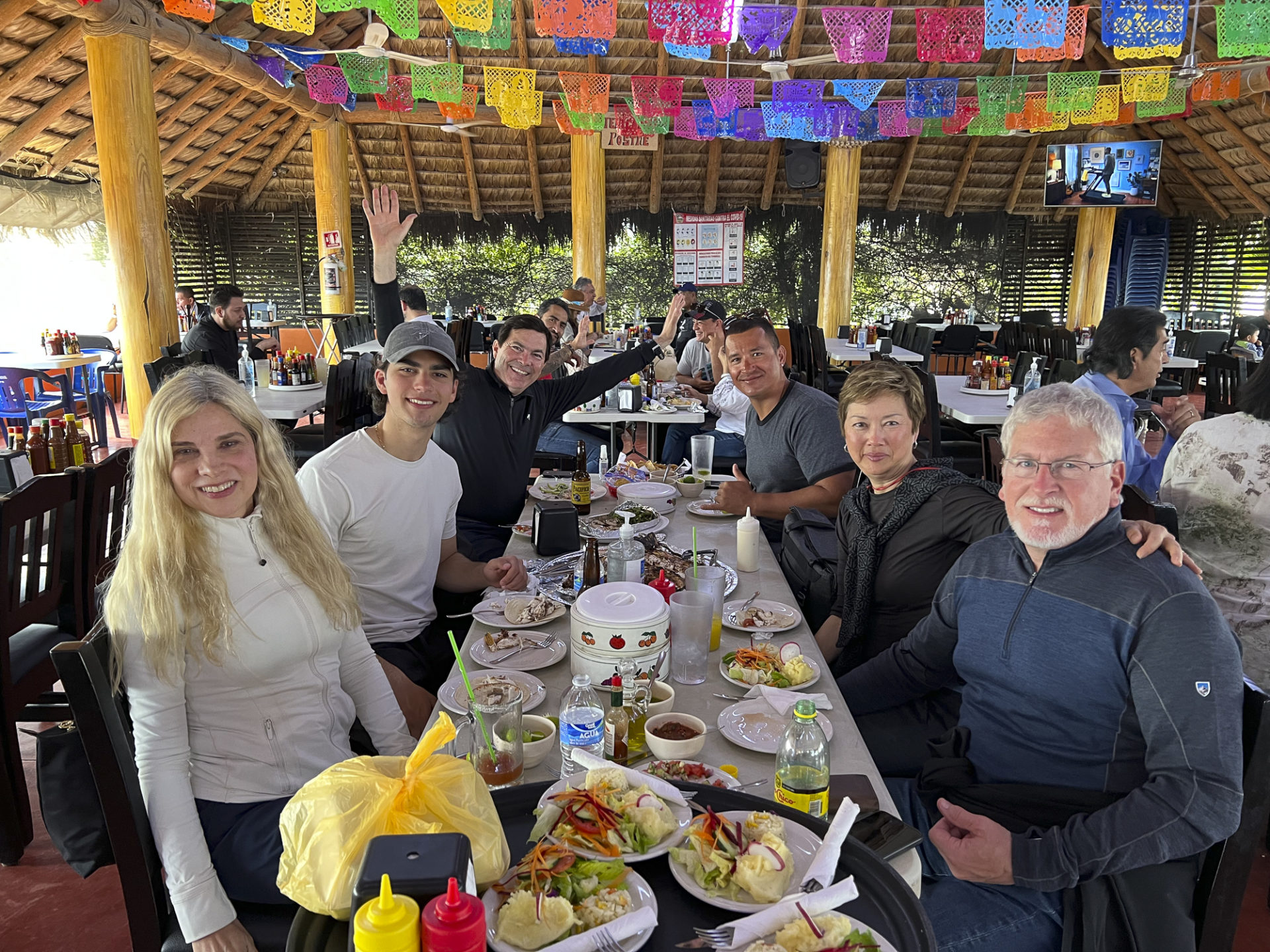
A sumptuous send-off lunch and satisfied smiles after a seafood extravaganza at Toro Guero (near the airport in San Jose del Cabo) with (left to right) Monterrey family Regina, son Abel, husband Abel, Garid, me and Steve. A great finale to an amazing trip!
At this writing, I still have whales on the mind. I found on a bookshelf at home a book I picked up somewhere but hadn’t cracked: Fluke: Or, I Know Why the Winged Whale Sings by Christopher Moore, which is set in the world of Maui humpback whale researchers. Steve and I had recently listened to another, completely different Christopher Moore novel, You Suck, a funny vampire tale set in the world of Goth teens in San Francisco. Somehow I made it through my formal education without ever reading that 1851 classic of American literature, Herman Melville’s Moby-Dick, so I am now remedying that by listening to an audiobook version of it. I was shocked to find the audiobook is 24 hours long! Maybe that explains why I had never attempted it before. Perhaps these readings will cure my whale fixation…but then again, I suspect strongly not. Much like how completely differently gray whales are seen now by adoring tourists vs. the “devil-fish” days of whalers, Moby-Dick was variably regarded in Melville’s lifetime but has evolved over time to be regarded as one of the Great American Novels, with its opening line “Call me Ishmael” among the most recognizable in American literature.
-Marie
Post-script, August 2023:
On a long flight home from Fiji, I stumbled on an enjoyable 2012 feature film based on an actual gray whale episode in 1988 which captured world-wide attention which I somehow largely missed, called Big Miracle, starring Drew Barrymore and John Krasinski. Back in 1988, a trio of gray whales were trapped near Barrow Alaska by early forming Arctic ice. A local reporter broke the story, which became a national obsession as an unlikely coalition of local Inupiats, Greenpeace, an oil executive and entrepreneurs raced to keep open a dwindling hole in the ice through which the whales were breathing and to find a way to get the whales to open water (an effort which ultimately involved the National Guard, a Russian icebreaker and many volunteers with chain saws). In 1988, I was a radiology resident, which partly explains (at least to me) why I only vaguely recall this episode, which rivetted the nation and the world.


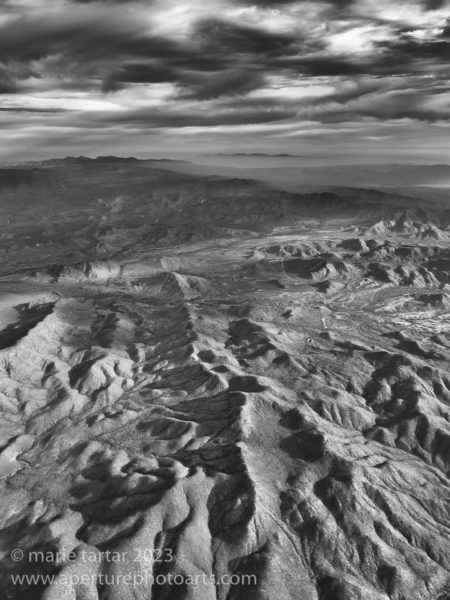



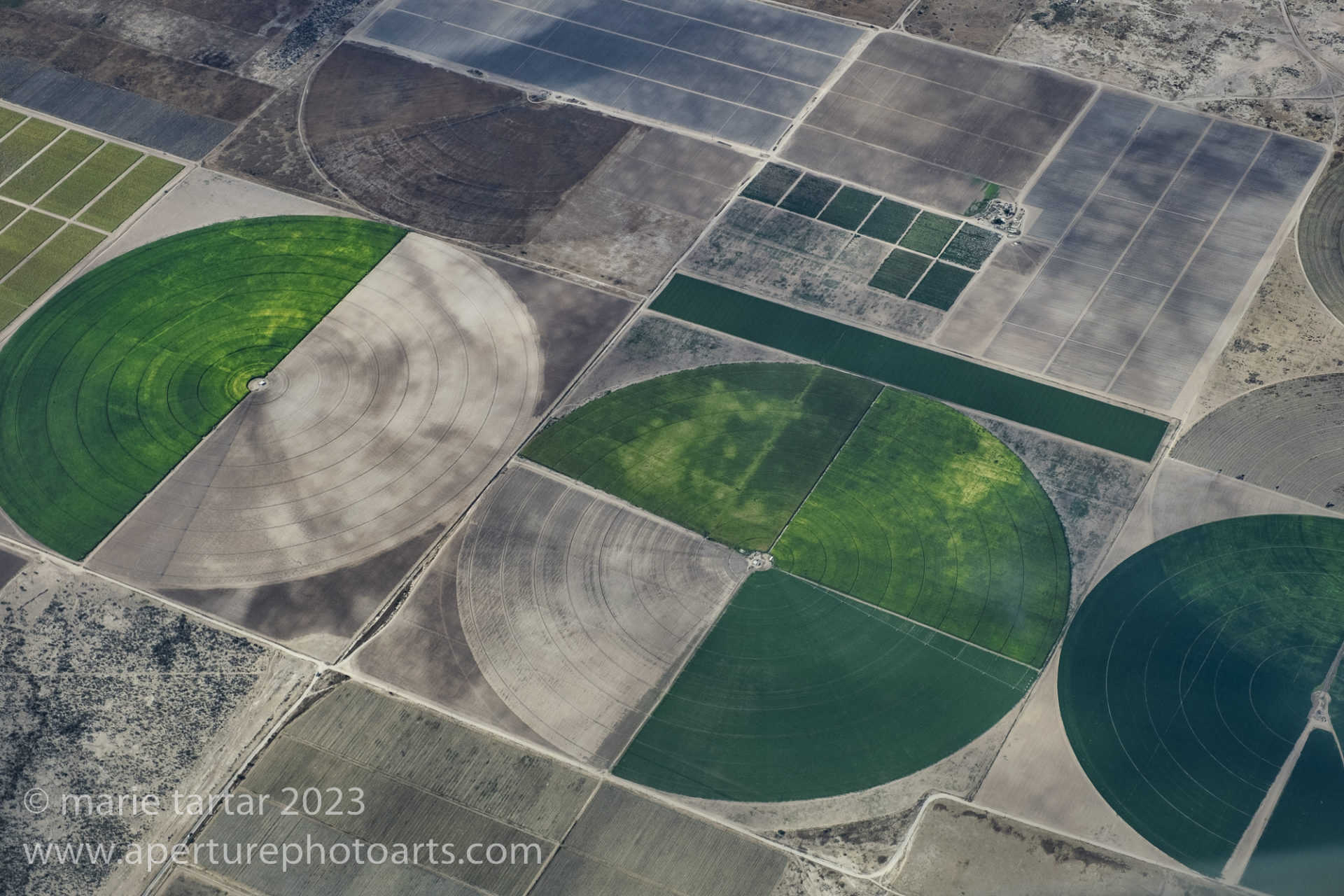
There is a place in Alaska known as Beluga Bay outside of Anchorage at Turnagain Arm. We were visiting my brother who lives in Alaska. When we went to the Bay we saw a pod of gorgeous white Belugas! You would love it !! Of course you might have already visited.
Debby Kline
We haven’t but your comment reminds me we have only been to Alaska once & there is much to explore there!
-Marie
We actually went panning for gold too. And found some! Went fishing in Seward and brought home 55 pounds of salmon. We are smoking the last batch today.
Marie! You captured this so perfectly! I felt like I was with you even for the parts I wasn’t. LOL! And your photos are incredible! I’m so glad Aimee and I got to meet you and Steve and Greg. It was such a unique and special experience that I’ll cherish forever. Also, this was such a yummy recap, I’m subscribing to add your blog to my regular follows. Keep in touch!
Glad you enjoyed it, Amber! You and Aimee really added to our enjoyment of this trip!
-Marie
Vicarious travels at their best!! Great stories & amazing images.
So glad to come upon your article! We are tentatively planning a trip just as yours with Baja Expeditions but I am debating on pushing it into February to be able to hopefully see mamas with babies. Or do you think March would be even better?? I am so excited. How were the tents? Glamping vs luxury glamping: is it worth it to spend more for a bigger tent??
I think by the second half of February or early March, the mothers will be less protective of the calves. Tents were quite comfortable, but we really only slept there, changed clothes and showered-there wasn’t a lot of time to hang out without skipping a whale session, which I wouldn’t do, so probably glamping would be fine.
-Marie